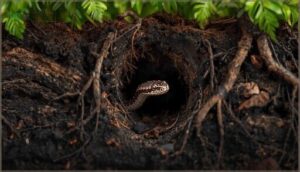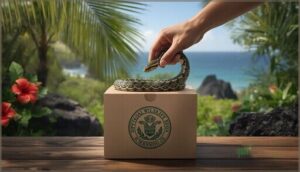This site is supported by our readers. We may earn a commission, at no cost to you, if you purchase through links.
 You won’t find a single native snake slithering through Hawaii’s rainforests, beaches, or volcanic slopes. This isn’t just a quirk of island biogeography—it’s a defining feature that shaped the evolution of Hawaii’s unique ecosystem for millions of years.
You won’t find a single native snake slithering through Hawaii’s rainforests, beaches, or volcanic slopes. This isn’t just a quirk of island biogeography—it’s a defining feature that shaped the evolution of Hawaii’s unique ecosystem for millions of years.
Native birds nest on the ground without fear, and endemic species developed no defenses against serpentine predators. That fragile balance makes Hawaii’s snake-free status more than a fun fact—it’s a matter of ecological survival.
The state guards this distinction fiercely with some of the strictest anti-snake laws in the nation, because even a single breeding population of the wrong species could trigger an environmental catastrophe that would devastate everything from native honeycreepers to the tourism economy.
Table Of Contents
- Key Takeaways
- Are There Snakes in Hawaii?
- Presence of Snakes in Hawaii
- Non-Native Snake Species
- Invasive Snakes and Their Threats
- Anti-Snake Legislation in Hawaii
- Snake Sightings and Reports
- Caught Snakes in Hawaii
- Snake Threats in Hawaii
- Hawaii’s Snake Amnesty Program
- Frequently Asked Questions (FAQs)
- Are there poisonous snakes in Hawaii?
- Are there yellow-bellied sea snakes in Hawaii?
- Does Hawaii have snakes?
- Are blind snakes native to Hawaii?
- Are snakes illegal in Hawaii?
- Are there brown tree snakes in Hawaii?
- How common are snakes in Hawaii?
- Is Hawaii still snake free?
- Does Hawaii have any poisonous snakes?
- How did snakes get to Hawaii?
- Conclusion
Key Takeaways
- Hawaii has zero native land snakes—only two non-native species exist: the harmless Brahminy Blind Snake and the Yellow-Bellied Sea Snake that rarely comes ashore.
- The state enforces the nation’s strictest anti-snake laws with penalties reaching $200,000 and three years imprisonment because introduced snakes could devastate native birds that evolved without defenses against serpentine predators.
- Brown Tree Snakes represent Hawaii’s greatest threat—they wiped out nine of twelve native bird species in Guam and could cost Hawaii between $593 million and $2.14 billion yearly if established.
- Hawaii’s Amnesty Program allows illegal snake owners to surrender animals without prosecution, while the 643-PEST hotline and rapid response teams work to intercept accidental introductions before populations establish.
Are There Snakes in Hawaii?
Hawaii stands apart from nearly every tropical destination on Earth—it has zero native land snakes. This native snake absence isn’t just a quirk of geography; it’s a defining feature of Hawaii’s ecosystem that shapes everything from bird populations to biosecurity policies.
However, you’ll find two non-native species that have established themselves: the tiny Brahminy Blind Snake, introduced from Asia in the late 1980s and now widespread across urban gardens, and the Yellow-Bellied Sea Snake, an occasional visitor to Hawaiian waters that rarely ventures onto shore.
The real concern involves introduced snake risks from species like the Brown Tree Snake, which could devastate Hawaii’s ecosystem if established. That’s why Hawaii maintains the nation’s strictest anti-snake legislation, with penalties reaching $200,000 and three years imprisonment. Preventing snake introductions protects Hawaii’s fragile wildlife—reporting snake sightings immediately helps maintain this delicate balance.
The state also has strict importation requirements to prevent further introductions.
Presence of Snakes in Hawaii
You won’t find any native land snakes slithering through Hawaii’s rainforests or beaches—the islands evolved in complete isolation, over 2,000 miles from the nearest continent. This native snake absence makes Hawaii exceptionally unique among tropical ecosystems worldwide. However, Hawaii’s snake status isn’t entirely snake-free anymore.
Two snake species exceptions exist today. The Brahminy Blind Snake, accidentally introduced from Asia in the late 1980s, now lives in gardens across most main islands. You might also encounter the Yellow-Bellied Sea Snake, a pelagic species occasionally drifting into Hawaiian waters but rarely coming ashore.
Snake introduction risks remain Hawaii’s top biosecurity concern. The ecosystem vulnerability is real—without natural predators, introduced snakes could devastate native birds and bats. That’s why public awareness matters. Report any snake sightings immediately to protect this fragile paradise from becoming another cautionary tale like Guam. Recent reports, including the capture of a boa, highlight the ongoing threat.
Non-Native Snake Species
While Hawaii doesn’t have native snakes, a couple of non-native species have found their way to the islands over the years. These arrivals didn’t swim here on purpose—they hitched rides or adapted to Hawaii’s warm climate after accidental introduction.
Let’s look at the two non-native snakes you might actually encounter in Hawaii.
Brahminy Blind Snake
This parthenogenetic reproduction champion—the Brahminy blind snake—arrived in Hawaii’s ecosystem during the 1930s, hitching rides in imported soil. You’ll rarely spot these 2–6 inch insectivores since they burrow underground, consuming ants and termites.
Unlike other invasive species threatening Hawaii’s delicate balance, these harmless creatures pose minimal ecosystem impact. Detection methods remain challenging due to their subterranean lifestyle, though control strategies aren’t necessary given their benign nature.
Yellow-Bellied Sea Snake
While blind snakes stay underground, you might encounter the yellow-bellied sea snake (Hydrophis platurus) drifting in Hawaii’s warm ocean currents. This pelagic marine snake species reaches Hawaiian waters naturally, though limited encounters occur since it rarely approaches shore.
Despite venom potency exceeding many terrestrial snakes, documented bites in Hawaii don’t exist. Its conservation status remains stable across tropical oceans. Unlike terrestrial invasive species threatening native birds, this offshore visitor poses minimal risk to Hawaii’s ecosystem or beachgoers.
Invasive Snakes and Their Threats
While Hawaii doesn’t have native snakes, several non-native species pose serious risks if they establish populations on the islands. These invasive snakes threaten Hawaii’s fragile ecosystem because they’ve no natural predators and can devastate native bird populations.
Here are the main species that authorities work hard to keep out of Hawaii.
Brown Tree Snake
You mightn’t expect a snake to bring an island to its knees, but the Brown Tree Snake proved just how wrong that assumption can be. This nocturnal predator, reaching lengths of 10 feet, decimated Guam’s bird populations—wiping out nine of twelve native forest bird species. The invasive species now threatens Hawaii’s wildlife with similar devastation.
The Brown Tree Snake devastated Guam’s ecosystem by wiping out nine of twelve native forest bird species—a chilling preview of what could happen in Hawaii
Here’s what makes this threat so serious:
- Power Outages: Guam suffers $4.5 million annually in electrical damage from snakes entering infrastructure
- Economic Impact: Hawaii faces potential losses between $593 million and $2.14 billion yearly if the snake becomes established
- Adaptation Skills: These climbers thrive without natural predators, reaching densities of 50 snakes per acre
- Impact on native wildlife: They prey relentlessly on birds, eggs, small mammals, and reptiles
- Control Measures: Hawaii maintains 32 traps at military airfields and inspects nearly all high-risk incoming vessels
Ball Python
Unlike the gentle captive ball pythons kept as pets worldwide, illegally introduced ball pythons in Hawaii pose serious ecological risks. These African constrictors reach 6 feet and threaten native birds with their adaptable hunting skills and calm python temperament. Here’s why they’re dangerous:
- Their ball python diet includes birds and eggs, devastating native species
- Without natural predators, populations explode unchecked
- Ball python morphs adapt easily to Hawaii’s varied habitats, enabling rapid spread
Boa Constrictor
Boa constrictors rank among Hawaii’s most dangerous illegal snakes due to their impressive size—reaching up to 12 feet—and deadly constricting methods that suffocate prey. These Central and South American natives thrive in Hawaii’s varied habitats, from rainforests to dry lowlands. Their captive care requirements are strict, yet some ignore laws, introducing them anyway.
These invasive species devastate native birds, small mammals, and eggs. Despite their generally calm temperament in captivity, wild populations would wreak havoc. Hawaii’s ecosystem simply can’t handle these uninvited constrictors.
| Boa Constrictor Characteristic | Threat Level | Impact on Hawaii |
|---|---|---|
| Size (up to 12 feet) | High | Preys on large native birds and mammals |
| Constricting methods | Severe | No defense mechanisms in native species |
| Habitat adaptability | Critical | Thrives in multiple Hawaiian ecosystems |
Garter Snake
The garter snake might look harmless, but don’t let its small size fool you. While garter snake venom is weak—a mild neurotoxin that rarely harms humans—these nonnative species still threaten Hawaii’s ecosystem.
Their adaptable garter snake habitat preferences and varied garter snake diet, which includes native birds, eggs, and small vertebrates, make them formidable competitors.
Snake identification matters here: recognizing this snake species helps you report sightings quickly. Despite garter snake myths suggesting they’re benign, these nonnative snakes disrupt the delicate balance you’ll want to protect.
Corn Snake
Corn snakes rank among the most popular pet snakes worldwide, prized for their docile temperament and stunning corn snake morphs ranging from vibrant oranges to subtle grays. Yet in Hawaii, these nonnative snakes represent a serious threat.
Escaped or released individuals adapt quickly, preying on native birds and eggs. Despite straightforward captive care requirements, escape risks remain high. Identification tips include orange-red patterns with black borders. If you spot this invasive species, report it immediately—Hawaii’s ecosystem depends on vigilance.
Anti-Snake Legislation in Hawaii
Hawaii is serious about keeping snakes out. The state has put together some of the toughest anti-snake laws in the country, backed by real enforcement and public cooperation.
Here’s how Hawaii protects its unique ecosystem from these invasive predators.
Importation Regulations
You can’t bring snakes into Hawaii—period. The state’s snake importation regulations make possession or import illegal, carrying fines up to $200,000 and three years in prison. Permit exceptions exist only for zoos and research facilities under strict quarantine measures.
Federal laws like the Lacey Act strengthen enforcement, though illegal trade and enforcement challenges persist. Hawaii’s antisnake legislation protects fragile ecosystems from devastating invasive species.
Monitoring at Ports of Entry
Ports of entry guard Hawaii’s borders through inspection technologies and biosecurity measures designed to block snake introduction. Wildlife inspectors screen cargo shipments at airports and harbors, processing over 170,000 declared items annually. Detector dogs trained for rapid response identify hidden snakes at key locations.
Inter-agency collaboration between federal and state agencies strengthens efforts to prevent snake introduction, while funding allocation underwrites ongoing monitoring. These coordinated snake importation regulations protect Hawaii’s vulnerable ecosystems from devastation.
Educational Initiatives
Hawaii’s educational programs bridge the gap between policy and practice, teaching you how to recognize and respond to snake threats. School programs integrate biosecurity messaging into classroom curricula, while community workshops equip locals and tourists with practical snake identification and safety skills. Public awareness campaigns use visitor education materials at airports and hotels, ensuring you understand your role in protecting the islands.
You’ll find snake species identification guides, smartphone apps, and interactive training sessions designed to help you distinguish harmless species from genuine threats. These initiatives emphasize snake encounters and safety protocols, transforming residents and visitors into vigilant guardians of Hawaii’s fragile ecosystems through accessible, actionable knowledge about snake identification and facts.
| Initiative Type | Target Audience | Key Focus |
|---|---|---|
| School Programs | Students K-12 | Species identification basics |
| Community Workshops | Residents | Response protocols |
| Visitor Education | Tourists | Biosecurity responsibilities |
| Public Awareness Campaigns | General public | Threat recognition |
| Digital Resources | All visitors | Real-time snake identification |
Reporting of Snake Sightings
When you encounter a snake on the islands, immediate reporting triggers rapid response protocols designed to protect Hawaii’s ecosystem. Your citizen involvement is vital—call 911 for confirmed snake sightings or use the 643-PEST hotline for suspected encounters. Identification guides help improve reporting accuracy, ensuring snake removal and control teams respond effectively.
Why your report matters:
- You become the first line of defense, preventing a single snake from becoming an established population
- Your vigilance protects endangered native birds that have no defenses against these predators
- Quick action saves Hawaii millions in potential ecological and economic damage
Snake encounters on the islands demand urgent attention. Hotline effectiveness depends on detailed information—describe the snake’s size, color patterns, and exact location. Don’t attempt capture; trained specialists handle snake control in Hawaii safely.
Educating locals and tourists about proper reporting procedures transforms everyone into ecosystem guardians, strengthening the state’s biosecurity network against invasive threats.
Conservation Efforts
Federal funding drives Hawaii’s multi-agency conservation strategy against snake invasions. Biosecurity measures are supported by strategic appropriations targeting brown tree snake prevention specifically—species protection that safeguards Hawaii’s unique ecosystem.
The Hawaii Invasive Species Council coordinates eradication strategies when needed, combining rapid detection with containment protocols.
Public engagement through educational outreach strengthens these ecosystem protection measures, transforming residents into active participants in preventing snake introduction and protecting Hawaii’s biodiversity.
Snake Sightings and Reports
Despite Hawaii’s strict laws, snakes still show up from time to time—whether someone smuggled them in or they hitched a ride by accident. When these sightings happen, authorities move quickly to contain the threat and protect the islands’ fragile ecosystem.
Let’s look at some notable examples of how Hawaii addresses these unwanted arrivals.
False King Cobra Sightings
Every few months, social media explodes with claims of king cobras lurking in Hawaiian yards—but media amplification often outpaces the truth. These dramatic reports of invasive snake species are almost always hoax potential or sighting misidentification. Here’s what drives public perception:
- Garden hoses, eels, and branches are common cobra look-alikes
- Photos spread online before experts can verify snake sightings in Hawaii
- No authenticated king cobra presence has ever been confirmed
- Wildlife authorities quickly debunk false nonnative snake threats
Confiscation and Amnesty Program
Through the Snake Amnesty Program, you can surrender illegal snakes to the Hawaii Department of Agriculture without facing reporting penalties—as long as you act before an investigation begins. Ball pythons and boa constrictors are among the species surrendered at confiscation locations like the Honolulu Zoo.
Amnesty effectiveness is clear: dozens of snakes removed yearly, zero prosecutions for voluntary surrenders, strengthening Hawaii’s anti-snake legislation.
Caught Snakes in Hawaii
Despite Hawaii’s strict laws, snakes still manage to slip through the cracks from time to time. When authorities catch these illegal reptiles, each case acts as a reminder of how vulnerable the islands are to invasion.
Here are two notable examples of snakes intercepted before they could establish populations in Hawaii.
Boa Constrictor in Honolulu Harbor
On August 3, 2023, a live 18-inch boa constrictor slithered across a cargo ship at Pier 31 in Honolulu Harbor before U.S. Customs agents and Hawaii Department of Agriculture inspectors cornered it. This marked the second illegal snake interception that year, highlighting ongoing risks despite strict biosecurity.
Here’s what makes boa constrictors particularly dangerous in Hawaii:
- No natural predators exist to control their population
- Adults reach 12 feet, threatening native birds and small mammals
- Penalties are severe: up to $200,000 in fines and 3 years imprisonment
The captured juvenile now resides at the Plant Quarantine Branch for educational purposes.
Gopher Snake at Home Depot on Oahu
On July 6, 2022, Home Depot employees in Kapolei discovered something unsettling inside a shipping container—a 21-inch juvenile gopher snake coiled among mixed goods. This stowaway snake, native to North America, represented another biosecurity failure despite Hawaii’s rigorous cargo inspections.
The snake encounters like this highlight how accidental snake arrivals slip through even the strictest monitoring. Agricultural inspectors quarantined the nonvenomous constrictor for 14 days, checking for salmonella and parasites.
While gopher snakes pose less immediate danger than brown tree snakes, their presence signals ongoing risks to Hawaii’s vulnerable bird populations and underscores why you should report any snake sightings in Hawaii immediately.
Snake Threats in Hawaii
Snakes don’t just represent a minor inconvenience for Hawaii—they’re a legitimate ecological disaster waiting to happen. Without natural predators or evolutionary defenses in place, Hawaii’s native species are sitting ducks if invasive snakes establish populations on the islands.
Let’s break down exactly why snakes pose such a serious threat to Hawaii’s unique ecosystem, wildlife, and even residents.
Lack of Natural Predators
Picture Hawaii’s unique ecosystem as a fortress that’s never needed walls—until now. Here’s why the threat of invasive species hits differently on these islands: you’re looking at an isolated environment where evolutionary defenses never developed against snakes. This absence of predators creates a perfect storm for unchecked population growth. Understanding island biogeography helps explain Hawaii’s ecosystem vulnerability:
- Brown tree snakes reached densities of 50 snakes per acre in Guam
- No native diseases or competitors exist to limit snake populations
- Hawaii’s isolation means zero natural predator-prey relationships with snakes
- Predation absence allows exponential reproduction rates
Without nature’s checks and balances, this island ecosystem faces serious risk.
Competition With Native Animals
When invasive snakes enter Hawaii’s unique ecosystem, they don’t just hunt—they compete directly with native species for every available resource. This leads to species displacement, as birds, small mammals, and reptiles face resource scarcity. The impact of snakes on ecosystem balance is severe: Guam lost nine of 12 native bird species after brown tree snakes arrived.
Bird population decline triggers food web changes, allowing insect populations to explode without natural predators. The threat of invasive species creates ecosystem imbalance that reverberates through Hawaii’s ecosystem, affecting plants that depend on birds for seed dispersal.
Preying on Birds and Eggs
Beyond simply competing for food, snakes actively hunt Hawaii’s native birds, which evolved without any defenses against these predators. Brown tree snakes consume up to 70% of their body weight daily in prey, including birds and eggs. This voracious appetite drives bird population decline at alarming speeds—Guam saw 12 of 18 native bird species disappear within a decade. Snake feeding habits include nocturnal nest raids when birds can’t defend themselves. Here’s why native bird vulnerability is so extreme:
- Hawaiian birds don’t recognize snakes as threats
- Egg predation rates can devastate breeding populations quickly
- Ground-nesting species face especially high predation risk
- Lost birds mean ecosystem disruption through reduced seed dispersal
Potential Threat to Humans and Pets
While birds face the greatest danger, you and your pets aren’t entirely safe either. The brown tree snake carries mild venom that can harm small children and pets through snake bites.
In Guam, these snakes caused $4.5 million in annual power outages by climbing electrical infrastructure. Economic impact projections for Hawaii reach $2.14 billion yearly if snake encounters become common—covering medical care, pet losses, and psychological impact from venomous snake threats.
Hawaii’s Snake Amnesty Program
If you’ve accidentally acquired a snake in Hawaii or know someone who’s, there’s a way out without facing legal trouble. The state runs an amnesty program that lets you surrender illegal animals with no questions asked.
Here’s how the program works and where you can turn in these prohibited pets.
Designated Drop-Off Locations
When you need to surrender a snake in Hawaii, the Amnesty Program offers legal protection through convenient drop-off locations. Hawaii Department of Agriculture Plant Quarantine Offices, municipal zoos like Honolulu Zoo and Panaewa Zoo, and local Humane Societies accept illegal animals without penalty under snake laws and regulations.
The surrender process prioritizes accessibility and confidentiality:
- Drop-off sites operate year-round across Oʻahu, Maui, Kauaʻi, Hawaiʻi Island, and Molokaʻi
- Animal handling follows protocols that avoid euthanization when possible
- Location accessibility ensures animal control remains practical for all residents
Understanding snake import regulations helps you participate responsibly in protecting Hawaii’s ecosystem.
Reporting Illegal Animals
Once you know where to drop off an illegal snake, you should also understand how to report sightings. Hawaii’s 24-hour Pest Hotline (808-643-PEST) accepts confidential reports about snakes and other prohibited animals.
The Amnesty Program protects you from fines up to $200,000 and prison time if you surrender animals before investigation.
The Hawaii Department of Agriculture coordinates interagency actions, responding within one hour to dangerous species reports while maintaining your anonymity throughout the process.
Frequently Asked Questions (FAQs)
Are there poisonous snakes in Hawaii?
You won’t find venomous snakes on land in Hawaii. The Yellow-Bellied Sea Snake is venomous but stays offshore.
The widespread Brahminy Blind Snake is completely harmless and nonvenomous, posing no danger to you.
Are there yellow-bellied sea snakes in Hawaii?
Yes, yellow-bellied sea snakes occasionally wash ashore in Hawaii, particularly at Waimanalo Beach and other coastal areas. These Pacific Ocean drifters arrive via currents and storms, though established populations haven’t formed, limiting ecological integration despite their venom toxicity.
Does Hawaii have snakes?
Hawaii maintains a snake-free environment through rigorous biosecurity measures. No native snake species exist here.
You’ll only encounter accidental introductions—quickly removed—preserving the Hawaiian Islands’ unique ecosystem from invasive threats that could devastate native wildlife.
Are blind snakes native to Hawaii?
To set the record straight, the Brahminy blind snake isn’t native to Hawaii.
This tiny species arrived accidentally from Southeast Asia, likely hitching rides in potted plants and soil shipments decades ago.
Are snakes illegal in Hawaii?
You can’t legally own, import, or sell snakes in Hawaii. Strict anti-snake legislation carries severe legal penalties—up to $200,000 in fines and three years in prison.
Snake importation regulations help protect fragile ecosystems.
Are there brown tree snakes in Hawaii?
An ounce of prevention beats a pound of cure—that’s why Hawaii fights hard to keep Brown Tree Snakes out.
These invasive snake species devastated Guam’s birds and economy, making interdiction effectiveness critical for island protection.
How common are snakes in Hawaii?
Snakes are exceptionally rare across the islands, with virtually no established populations.
You’ll find the occasional Brahminy Blind Snake underground or, even more uncommonly, a Yellow-Bellied Sea Snake washed ashore during unusual ocean currents.
Is Hawaii still snake free?
Officially, Hawaii maintains its snake-free status despite the naturalized Brahminy Blind Snake and occasional Yellow-Bellied Sea Snake sightings.
Strict interception success at ports prevents breeding populations from establishing, protecting the Hawaiian Islands from non-native snake introductions.
Does Hawaii have any poisonous snakes?
Hawaii has no native venomous snakes on land. The Yellow-bellied Sea Snake, highly venomous but rarely seen in Hawaiian waters, poses minimal risk.
Brown Tree Snakes remain a concerning invasive threat requiring immediate reporting if spotted.
How did snakes get to Hawaii?
Most snakes reached Hawaii through cargo shipments from Guam, illegal pet trade smuggling, and accidental imports in shipping containers. The Brahminy blind snake arrived in potted plants during the 1930s, while yellow-bellied sea snakes occasionally swim to Hawaiian waters naturally.
Conclusion
Like guardians at the gate, Hawaii’s strict laws and vigilant monitoring systems stand between the islands and ecological collapse. The answer to “are there snakes in Hawaii” remains a definitive no for native species—and authorities intend to keep it that way.
Every confiscated python, every reported sighting, and every educational campaign reinforces the same truth: this isn’t just about snakes. It’s about preserving an irreplaceable world that evolved without them.
- https://a-z-animals.com/animals/snake/snake-facts/invasive-snakes-in-hawaii/
- https://hawaiisbesttravel.com/are-there-snakes-in-hawaii/
- https://governor.hawaii.gov/newsroom/hdoa-news-release-on-sea-snake-found-ashore/
- https://dab.hawaii.gov/chair/newsreleases/two-dead-snakes-turned-in-this-week/
- https://alohastatedaily.com/2025/06/19/skunk-captured-in-kakaako/















